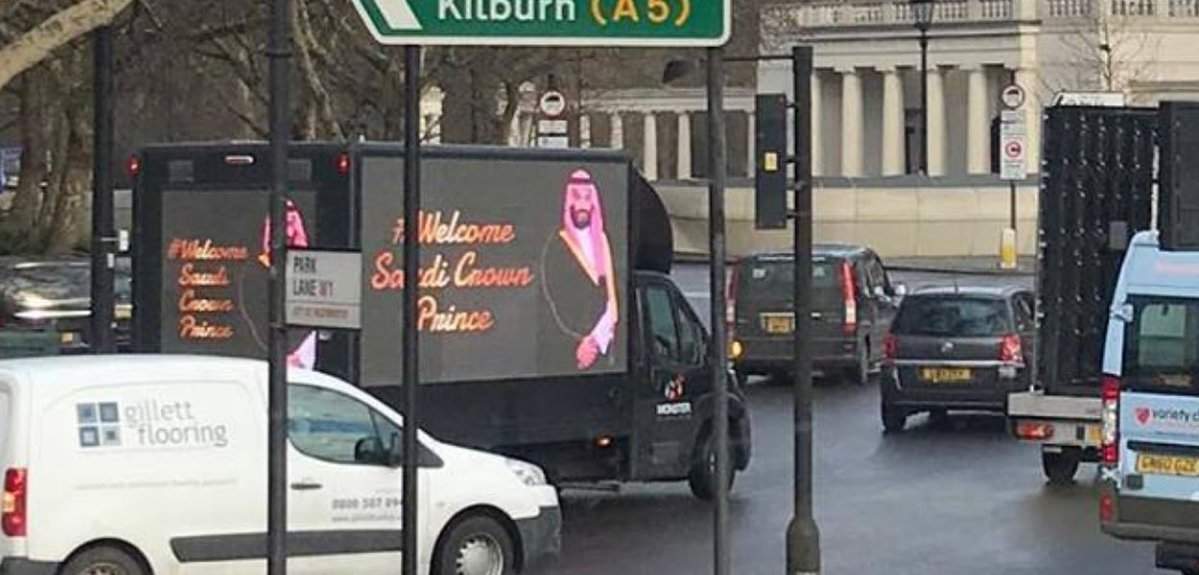
Saudi Arabia spared no expense painting London green with ads and billboards heralding the arrival of their powerful crown prince in the UK this week, in a multi-million pound ad campaign.
Billboards mounted on trucks and branded black cabs with “#Welcome Saudi Crown Prince” slogans were among the marketing tactics used by Mohammed bin Salman who seen by many as a moderniser and reformer.
No country for bad press
While residents in the Gulf may be accustomed to having their streets and newspapers emblazoned with the faces of airbrushed monarchs, it came as something of a culture shock to the British public.
One motorist driving down the M4 & M40 motorway on Tuesday morning to be “greeted” by Saudi Arabia’s “beloved leader” reported “feeling like I was arriving in Riyadh,” the Saudi capital.
Feels like arriving in #Riyadh – when entering London from the M4 & M40 one is greeted by the “beloved leader” #MbS – @AEISaudi & the #Saudi lobby try to turn around the kingdom’s image in a not so subtle way @alekhbariyatv pic.twitter.com/Gb8rwuYiUK
— Dr Andreas Krieg (@andreas_krieg) March 6, 2018
How well do you really know your competitors?
Access the most comprehensive Company Profiles on the market, powered by GlobalData. Save hours of research. Gain competitive edge.
 Company Profile – free sample
Company Profile – free sampleThank you!
Your download email will arrive shortly
Not ready to buy yet? Download a free sample
We are confident about the unique quality of our Company Profiles. However, we want you to make the most beneficial decision for your business, so we offer a free sample that you can download by submitting the below form
By GlobalData
The British newspapers were also peppered with ads, with the Evening Standard, FT, the Times and Telegraph, all carrying adverts which lauded the young prince for his modernising agenda and success opening up a country that was traditionally conservative and closed.
One full-page ad in the FT (which costs as much as £64,300 according to the paper’s rate card), read “United Kingdoms UKSA” accompanied by maps of the two countries.
The advertising tally in the FT alone this week came to £361,644 according to the published rate card (although just a guide).
The @FT has doing well from the UK visit of the Saudi Crown Prince. One full page, three half page ads. pic.twitter.com/gweZ4GrJ77
— Lindsey Hilsum (@lindseyhilsum) March 7, 2018
The ad campaign was purchased by Arabian Enterprise Incubators, a consultancy founded by a former employee of weapons company BAE Systems, Adam Hosier.
A twitter account was also set up a month before the visit seemingly with the express purpose of tweeting words of welcome to the prince in English and Arabic.
Twitter users complained of being targeted by ads promoting the site, while Reddit promoted it.
The Guardian also featured an ad promoting the prince on International Women’s Day of a veiled woman in a car, reading: “He is empowering Saudi Women.”
But why the huge fanfare?
The media blitz is directed towards UK and Saudi audiences, says former US diplomat and vice president of consulting firm B&K International Charles Kestenbaum.
“Both are essential to his success. He must be seen as a success back home and he must be seen as being welcome in global financial markets, especially London,” he told Verdict.
“$5 or $10 million it is a small price to pay for vast media coverage. Britain is still the historic colonial power and the force most closely associated with the several centuries of Euro influence on the Middle East.
“Convincing global and especially US-Euro markets that Saudi is reforming and opening up and becoming less corrupt and more transparent, also figures prominently in the young princes foreign policy strategy.
“Listing Aramco in global markets is another manifestation of this intention,” he said.
“So there are some very strong incentives for the Crown Prince to seek to control and direct the media coverage of his visit.
The 32-year-old prince was accompanied by a retinue of trade and investment ministers, on his global tour of Egypt, the UK, and the US, with hopes of scoring $100 billion in business deals.
Apart from giving a shot in the arm to UK’s lagging newspaper industry, the UK also stands to gain from trade deals with the oil-rich state, that could be a lifeline for post-Brexit Britain.
The Evening Standard, whose editor is former Tory finance minister George Osborne, featured an editorial as the prince arrived in the country, echoing the sentiments of the current Conservative government:
“We want the Saudi sponsorship of Wahhabist Islamist extremism around the world to end immediately,” it said, listing oppression of women, and rampant corruption associated with massive oil wealth as other things they hope the crown prince’s reign will bring.
“Mohammed bin Salman is the best hope we have — let’s welcome him and let’s work with him.”





